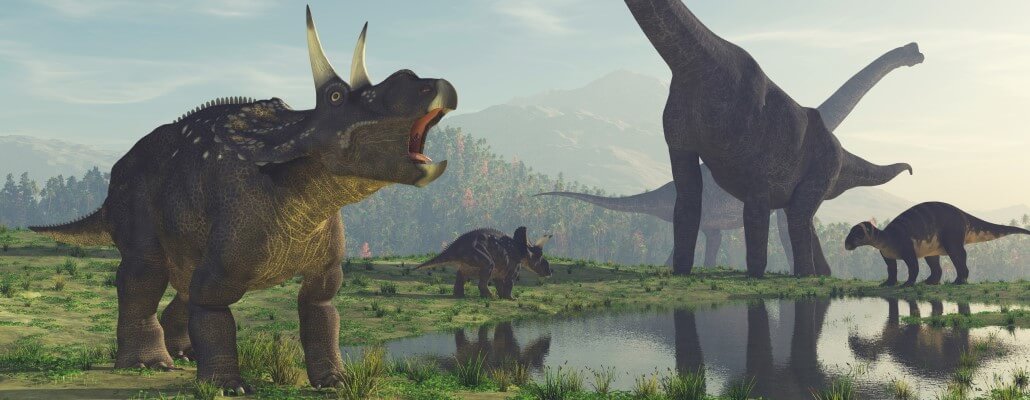As it stands, there are over 700 known species of dinosaur, but the actual number is likely much, much higher. With each new discovery that palaeontologists make (scientists who study fossils and dinosaurs), more is revealed about these amazing creatures.
This posts lists the majority of known dinosaur species beginning with the letter A. Some of the most recognisable dinosaurs in this post include the Allosaurus and Apatosaurus (formerly known as Brontosaurus).
Read on to learn more about the 66 known dinosaurs that begin with the letter A!
Explore Dinosaur Species
Explore the Dinosaur A to Z
- Dinosaurs beginning with A
Aardonyx
Aardonyx, meaning Greek for “earth claw”, was pronounced ARD-oh-nix. It was a Herbivore that was found in the Woodlands of southern Africa during the Early Jurassic period, around 195 million years ago. It was 20 feet long and weighed around 1,000 pounds, and its notable characteristics were: Long neck and tail; long, low-slung body.
Abelisaurus
Abelisaurus, meaning Greek for “Abel’s lizard”, was pronounced AY-bell-ih-SORE-us. It was a Carnivore that was found in the Woodlands of South America during the Late Cretaceous period, around 85-80 million years ago. It was 30 feet long and weighed around 2 tons, and its notable characteristics were: Large head with small teeth; openings in skull above jaws.
Abrictosaurus
Abrictosaurus, meaning Greek for “waking lizard”, was pronounced AH-brick-toe-SORE-us. It was a Herbivore that was found in the Woodlands of southern Africa during the Early Jurassic period, around 200 million years ago. It was four feet long and weighed around 100 pounds, and its notable characteristics were: Small size; a combination of beak and teeth.
Abrosaurus
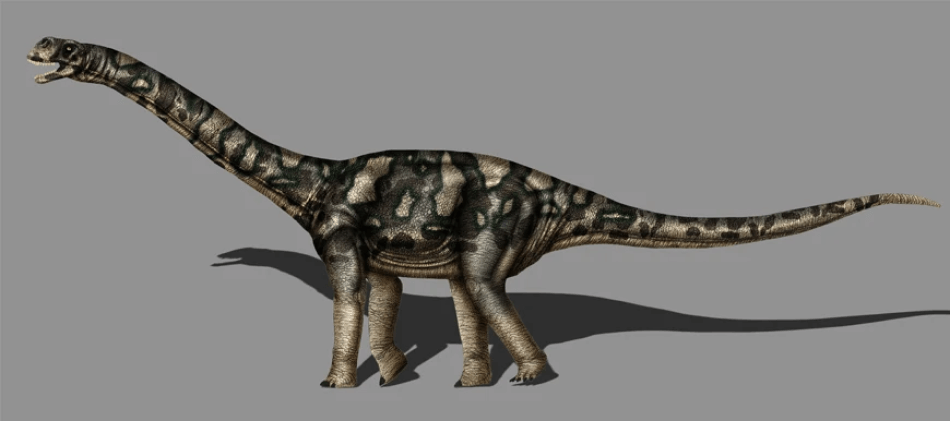
Abrosaurus, meaning Greek for “delicate lizard”, was pronounced AB-roe-SORE-us. It was a Herbivore that was found in the Woodlands of Asia during the Middle Jurassic period, around 165-160 million years ago. It was 30 feet long and weighed around five tons, and its notable characteristics were: Moderate size; short, boxy skull.
Abydosaurus
Abydosaurus, meaning Greek for “Abydos lizard”, was pronounced ah-BUY-doe-SORE-us. It was a Herbivore that was found in the Woodlands of North America during the Middle Cretaceous period, around 105 million years ago. It was 50 feet long and weighed around 10-20 tons, and its notable characteristics were: Large size; long neck and tail.
Acanthopholis
Acanthopholis, meaning Greek for “spiny scales”, was pronounced ah-can-THOFF-oh-liss. It was a Herbivore that was found in the Woodlands of western Europe during the Middle Cretaceous period, around 110-100 million years ago. It was 13 feet long and weighed around 800 pounds, and its notable characteristics were: Thick, oval-shaped armor; pointed beak.
Achelousaurus
Achelousaurus, meaning Greek for “Achelous lizard”, was pronounced AH-kell-oo-SORE-us. It was a Herbivore that was found in the Woodlands of North America during the Late Cretaceous period, around 80-65 million years ago. It was 20 feet long and weighed around one ton, and its notable characteristics were: Medium size; large frill; bony knobs above eyes.
Achillobator
Achillobator, meaning combination Greek/Mongolian for “Achilles warrior, was pronounced ah-KILL-oh-bate-ore. It was a Carnivore that was found in the Plains of Central Asia during the Late Cretaceous period, around 95-85 million years ago. It was 20 feet long and weighed around 500 to 1,000 pounds, and its notable characteristics were: Large size; huge claws on feet; odd alignment of hips.
Adamantisaurus

Adamantisaurus, meaning Greek for “Adamantina lizard”, was pronounced ADD-ah-MANT-ih-SORE-us. It was a Herbivore that was found in the Woodlands of South America during the Late Cretaceous period, around 75-65 million years ago. It was Up to 100 feet long and weighed around 100 tons, and its notable characteristics were: Large size; long neck and tail; probably armor.
Adasaurus
Adasaurus, meaning Greek for “Ada lizard”, was pronounced AY-dah-SORE-us. It was a Carnivore that was found in the Woodlands of central Asia during the Late Cretaceous period, around 75-65 million years ago. It was 5 feet long and weighed around 50-75 pounds, and its notable characteristics were: Tall skull; short claws on hind feet; probable feathers.
Adeopapposaurus
Adeopapposaurus, meaning Greek for “far-eating lizard”, was pronounced AD-ee-oh-PAP-oh-SORE-us. It was a Herbivore that was found in the Woodlands of South America during the Early Jurassic period, around 200 million years ago. It was 10 feet long and weighed around 150 pounds, and its notable characteristics were: Long neck and tail; horny beak.
Aegyptosaurus
Aegyptosaurus, meaning Greek for “Egyptian lizard”, was pronounced ay-JIP-toe-SORE-us. It was a Herbivore that was found in the Woodlands of northern Africa during the Middle Cretaceous period, around 100-95 million years ago. It was 50 feet long and weighed around 12 tons, and its notable characteristics were: Long neck and tail; relatively long legs.
Aeolosaurus
Aeolosaurus, meaning Greek for “Aeolus lizard”, was pronounced AY-oh-low-SORE-us. It was a Herbivore that was found in the Woodlands of South America during the Late Cretaceous period, around 75-65 million years ago. It was 50 feet long and weighed around 10-15 tons, and its notable characteristics were: Large size; forward-pointing spines on tailbones.
Agilisaurus
Agilisaurus, meaning Greek for “agile lizard”, was pronounced AH-jih-lih-SORE-us. It was a Herbivore that was found in the Woodlands of eastern Asia during the Middle Jurassic period, around 170-160 million years ago. It was four feet long and weighed around 75-100 pounds, and its notable characteristics were: Small size; lightweight build; stiff tail.
Agujaceratops
Agujaceratops, meaning Greek for “Aguja horned face”, was pronounced ah-GOO-hah-SEH-rah-tops. It was a Herbivore that was found in the Woodlands of southern North America during the Late Cretaceous period, around 77 million years ago. It was 15 feet long and weighed around 2 tons, and its notable characteristics were: Large, two-lobed frill; horns over eyes.
Agustinia
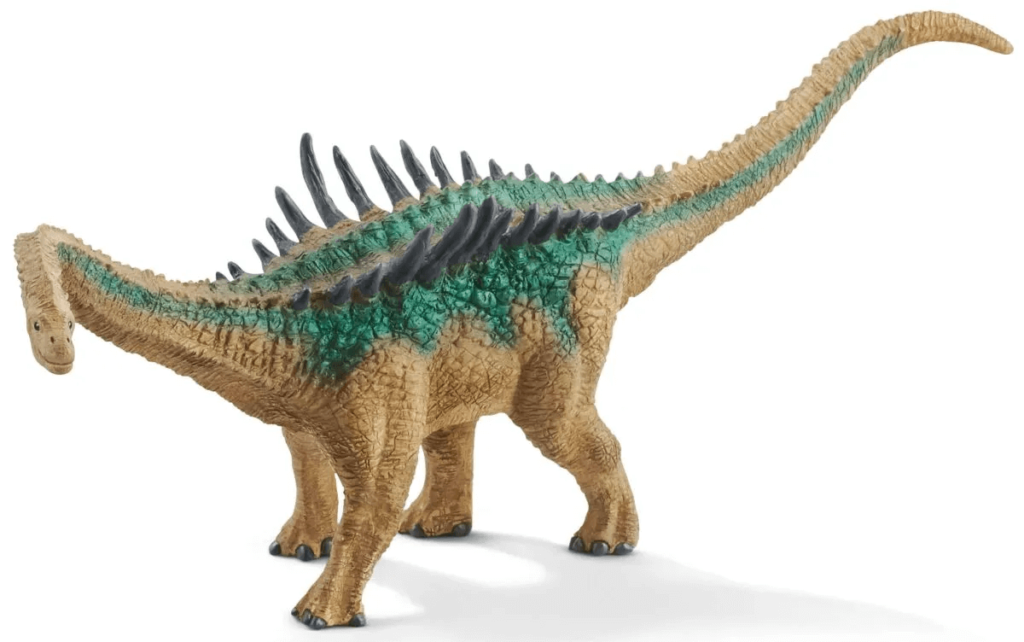
Agustinia, meaning after paleontologist Agustin Martinelli, was pronounced ah-gus-TIN-ee-ah. It was a Herbivore that was found in the Woodlands of South America during the Early-Middle Cretaceous period, around 115-100 million years ago. It was 50 feet long and weighed around 10-20 tons, and its notable characteristics were: Large size; spines jutting out from vertebrae.
Ajkaceratops
Ajkaceratops, meaning Greek for “Ajka horned face”, was pronounced EYE-kah-SEH-rah-tops. It was a Herbivore that was found in the Woodlands of central Europe during the Late Cretaceous period, around 85 million years ago. It was 3 feet long and weighed around 30-40 pounds, and its notable characteristics were: Small size; short frill.
Albalophosaurus
Albalophosaurus, meaning Greek for “white-crested lizard”, was pronounced AL-bah-LOW-foe-SORE-us. It was a Herbivore that was found in the Woodlands of eastern Asia during the Early Cretaceous period, around 140-130 million years ago. It was Undisclosed and weighed around N//A, and its notable characteristics were: Small size; bipedal posture; thickened skull.
Albertaceratops
Albertaceratops, meaning Greek for “Alberta horned face”, was pronounced al-BERT-ah-SEH-rah-tops. It was a Herbivore that was found in the Woodlands of North America during the Late Cretaceous period, around 80-75 million years ago. It was 10 feet long and weighed around 2-3 tons, and its notable characteristics were: Long brow horns; Centrosaurus-like skull.
Albertadromeus
Albertadromeus, meaning Greek for “Alberta runner”, was pronounced al-BERT-ah-DRO-may-us. It was a Herbivore that was found in the Plains of North America during the Late Cretaceous period, around 80-75 million years ago. It was five feet long and weighed around 25-30 pounds, and its notable characteristics were: Small size; long hind legs.
Albertonykus
Albertonykus, meaning Greek for “Alberta claw”, was pronounced al-BERT-oh-NYE-cuss. It was a Insects that was found in the Woodlands of North America during the Late Cretaceous period, around 70 million years ago. It was 2 1/2 feet long and weighed around a few pounds, and its notable characteristics were: Small size; claws on hands; probably feathers.
Aletopelta
Aletopelta, meaning Greek for “wandering shield”, was pronounced ah-LEE-toe-PELL-ta. It was a Herbivore that was found in the Woodlands of southern North America during the Late Cretaceous period, around 80-70 million years ago. It was 20 feet long and weighed around one ton, and its notable characteristics were: Low-slung body; spikes on shoulders; clubbed tail.
Alioramus
Alioramus, meaning Greek for “different branch”, was pronounced AH-lee-oh-RAY-muss. It was a Carnivore that was found in the Woodlands of Asia during the Late Cretaceous period, around 70-65 million years ago. It was 20 feet long and weighed around 500-1,000 pounds, and its notable characteristics were: Moderate size; numerous teeth; bony crests on snout.
Allosaurus
Allosaurus, meaning Greek for “strange” or “different” lizard, was pronounced AL-oh-saw-russ. It was a Carnivore that was found in Portugal and the USA during the Late Jurassic period, around 156-144 million years ago. It was up to 39 feet long and weighed up to 4,400 pounds, and its notable characteristics were: Moderate size; backward curbed teeth that were 5-10cm long to prevent prey escaping. It had a huge skull on a relatively short neck.
Altirhinus
Altirhinus, meaning Greek for “high nose”, was pronounced AL-tih-RYE-nuss. It was a Herbivore that was found in the Woodlands of Central Asia during the Middle Cretaceous period, around 125-100 million years ago. It was 26 feet long and weighed around 2-3 tons, and its notable characteristics were: Long, stiff tail; strange crest on the snout.
Alvarezsaurus
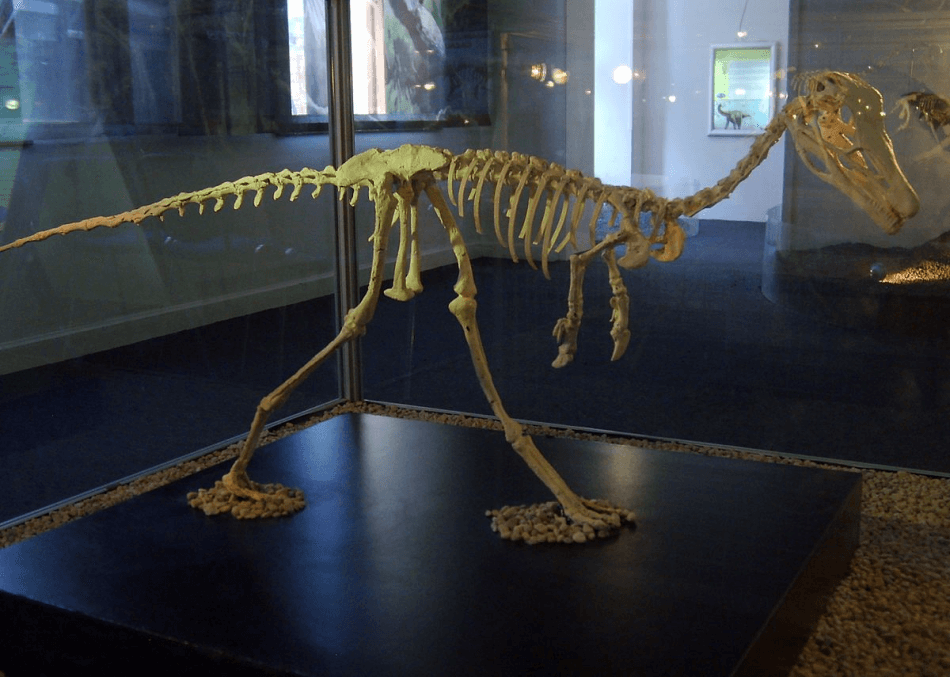
Alvarezsaurus, meaning Greek for “Alvarez’s lizard”, was pronounced al-vah-rez-SORE-us. It was a Probably insects that was found in the Woodlands of South America during the Late Cretaceous period, around 85 million years ago. It was 6 feet long and weighed around 30-40 pounds, and its notable characteristics were: Long legs and tail; probably feathers.
Alwalkeria
Alwalkeria, meaning after the paleontologist Alick Walker, was pronounced AL-walk-EAR-ee-ah. It was a Uncertain; possibly omnivorous that was found in the Woodlands of southern Asia during the Late Triassic period, around 220 million years ago. It was Undisclosed and weighed around N//A, and its notable characteristics were: Bipedal posture; small size.
Alxasaurus
Alxasaurus, meaning Greek for “Alxa desert lizard”, was pronounced ALK-sah-SORE-us. It was a Herbivore that was found in the Woodlands of Central Asia during the Middle Cretaceous period, around 110-100 million years ago. It was 12 feet long and weighed around a few hundred pounds, and its notable characteristics were: Big gut; narrow head and neck; large claws on front hands.
Amargasaurus
Amargasaurus, meaning Greek for “La Amarga lizard:, was pronounced ah-MAR-gah-SORE-us. It was a Herbivore that was found in the Woodlands of South America during the Early Cretaceous period, around 130 million years ago. It was 30 feet long and weighed around three tons, and its notable characteristics were: Relatively small size; prominent spines lining neck and back.
Amazonsaurus
Amazonsaurus, meaning Greek for “Amazon lizard”, was pronounced AM-ah-zon-SORE-us. It was a Herbivore that was found in the Woodlands of South America during the Early Cretaceous period, around 125-100 million years ago. It was 40 feet long and weighed around five tons, and its notable characteristics were: Moderate size; long neck and tail.
Ampelosaurus
Ampelosaurus, meaning Greek for “vineyard lizard”, was pronounced AMP-ell-oh-SORE-us. It was a Herbivore that was found in the Woodlands of Europe during the Late Cretaceous period, around 70-65 million years ago. It was 50 feet long and weighed around 15-20 tons, and its notable characteristics were: Spiky armor on back, neck, and tail.
Amphicoelias
Amphicoelias, meaning Greek for “double hollow”, was pronounced AM-fih-SEAL-ee-us. It was a Herbivore that was found in the Woodlands of North America during the Late Jurassic period, around 150 million years ago. It was Up to 200 feet long and weighed around 125 tons, but more likely 80 feet long and 50 tons, and its notable characteristics were: Enormous size; quadrupedal posture; long neck and tail.
Amurosaurus
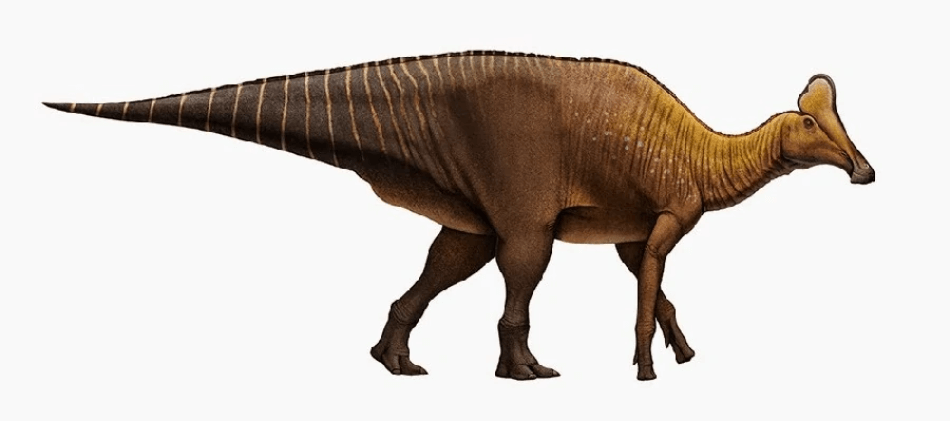
Amurosaurus, meaning Greek for “Amur River lizard”, was pronounced AM-ore-oh-SORE-us. It was a Herbivore that was found in the Woodlands of Asia during the Late Cretaceous period, around 75-65 million years ago. It was 25 feet long and weighed around 2 tons, and its notable characteristics were: Large size; narrow snout; small crest on head.
Anabisetia
Anabisetia, meaning after the archaeologist Ana Biset, was pronounced AH-an-biss-ET-ee-ah. It was a Herbivore that was found in the Woodlands of South America during the Late Cretaceous period, around 95 million years ago. It was 6-7 feet long and weighed around 40-50 pounds, and its notable characteristics were: Small size; bipedal posture.
Anatotitan
Anatotitan, meaning Greek for “giant duck”, was pronounced ah-NAH-toe-TIE-tan. It was a Herbivore that was found in the Woodlands of North America during the Late Cretaceous period, around 65 to 70 million years ago. It was 40 feet long and weighed around 5 tons, and its notable characteristics were: Large size; broad, flat bill.
Anchiceratops
Anchiceratops, meaning Greek for “near the horned face”, was pronounced ANN-chi-SEH-rah-tops. It was a Herbivore that was found in the Woodlands of North America during the Late Cretaceous period, around 70 million years ago. It was 12 feet long and weighed around 1-2 tons, and its notable characteristics were: Moderate size; paired brow horns; notched frill.
Anchiornis
Anchiornis, meaning Greek for “almost bird”, was pronounced ANN-kee-OR-niss. It was a Probably insects that was found in the Woodlands of Asia during the Late Jurassic period, around 155 million years ago. It was one foot long and weighed around a few ounces, and its notable characteristics were: Small size; feathers on front and back limbs.
Anchisaurus
Anchisaurus, meaning Greek for “near lizard”, was pronounced ANN-kih-SORE-us. It was a Herbivore that was found in the Woodlands of eastern North America during the Early Jurassic period, around 190 million years ago. It was six feet long and weighed around 75 pounds, and its notable characteristics were: Long, slim body; ridged teeth for shredding leaves.
Andesaurus
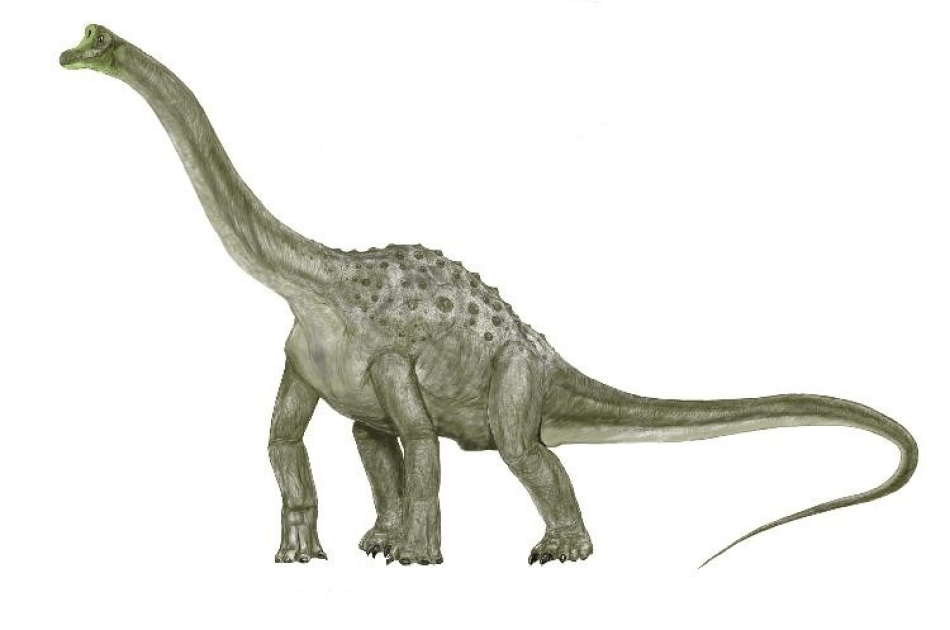
Andesaurus, meaning Greek for “Andes lizard”, was pronounced AHN-day-SORE-us. It was a Herbivore that was found in the Woodlands of South America during the Middle Cretaceous period, around 100-95 million years ago. It was 130 feet long and weighed around unknown, and its notable characteristics were: Long neck and tail; relatively long legs.
Angolatitan
Angolatitan, meaning Greek for “Angola giant”, was pronounced ang-OH-la-tie-tan. It was a Herbivore that was found in the Deserts of Africa during the Late Cretaceous period, around 90 million years ago. It was Unknown and weighed around N//A, and its notable characteristics were: Long neck and tail; probably light armor.
Angulomastacator
Angulomastacator, meaning Greek for “bent chewer”, was pronounced ANG-you-low-MASS-tah-kay-tore. It was a Herbivore that was found in the Woodlands of North America during the Late Cretaceous period, around 80-70 million years ago. It was 25-30 feet long and weighed around 1-2 tons, and its notable characteristics were: Narrow snout; oddly shaped upper jaw.
Animantarx
Animantarx, meaning Greek for “living fortress”, was pronounced AN-ih-MAN-tarks. It was a Herbivore that was found in the Woodlands of North America during the Middle-Late Cretaceous period, around 100-90 million years ago. It was 10 feet long and weighed around 1,000 pounds, and its notable characteristics were: Low-slung posture; horns and spikes along back.
Anodontosaurus
Anodontosaurus, meaning Greek for “toothless lizard”, was pronounced ANN-oh-DON-toe-SORE-us. It was a Herbivore that was found in the Woodlands of North America during the Late Jurassic period, around 75-65 million years ago. It was 20 feet long and weighed around two tons, and its notable characteristics were: Squat torso; heavy armor; large tail club.
Antarctopelta
Antarctopelta, meaning Greek for “Antarctic shield”, was pronounced ant-ARK-toe-PELL-tah. It was a Herbivore that was found in the Woodlands of Antarctica during the Middle Cretaceous period, around 100-95 million years ago. It was 13 feet long and weighed around unknown, and its notable characteristics were: Squat, armored body; large teeth.
Antarctosaurus
Antarctosaurus, meaning Greek for “southern lizard”, was pronounced ann-TARK-toe-SORE-us. It was a Herbivore that was found in the Woodlands of South America during the Late Cretaceous period, around 80-65 million years ago. It was 60 feet to 100 feet long and weighed around 50 to 100 tons, and its notable characteristics were: Square, blunt head with peg-shaped teeth.
Antetonitrus
Antetonitrus, meaning Greek for “before the thunder”, was pronounced AN-tay-tone-EYE-truss. It was a Herbivore that was found in the Woodlands of Africa during the Late Triassic period, around 215-205 million years ago. It was 30 feet long and weighed around two tons, and its notable characteristics were: Long neck; thick trunk; grasping toes on feet.
Anzu
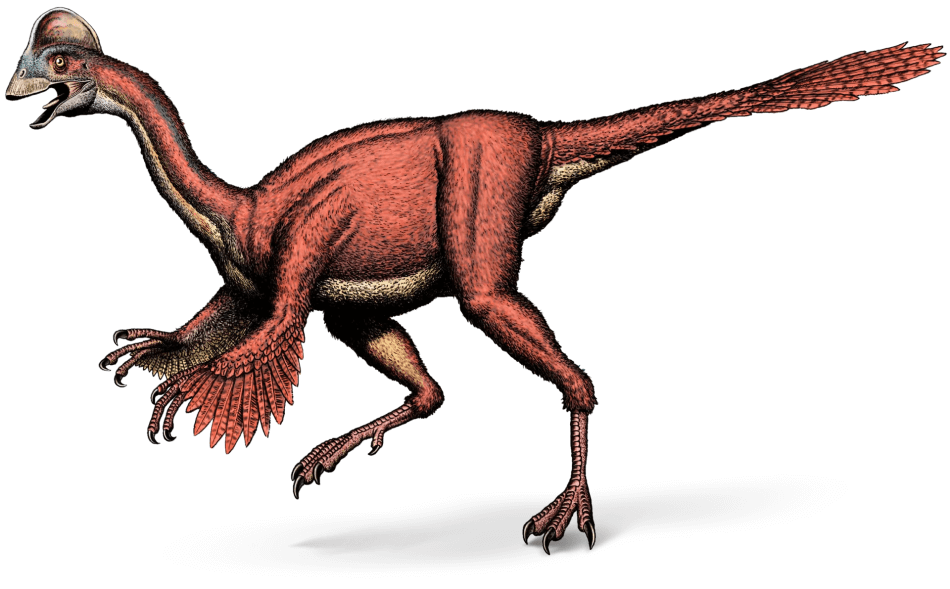
Anzu, named after a demon in Mesopotamian mythology, was pronounced AHN-zoo. It was a Probably omnivorous that was found in the Plains of North America during the Late Cretaceous period, around 70-65 million years ago. It was 11 feet long and weighed around 500 pounds, and its notable characteristics were: Bipedal posture; feathers; crest on head.
Aorun
Aorun, named after a Chinese deity, was pronounced AY-oh-run. It was a carnivore that was found in the Woodlands of Asia during the Late Jurassic period, around 160 million years ago. It was two feet long and weighed a few pounds, and its notable characteristics were: Small size; slender build.
Apatosaurus
Apatosaurus, meaning “deceptive lizard”, was pronounced ah-PAT-oh-sore-us. It used to be known as Brontosaurus. It was a herbivore that was found in North America during the Late Jurassic period, around 154-145 million years ago. It was up to 68 feet long and weighed up to 45 tons , and its notable characteristics were: a very long neck and tail, with four massive pillar-like legs.
Aquilops
Aquilops, meaning Greek for “eagle face”, was pronounced ACK-will-ops. It was a Herbivore that was found in the Woodlands of North America during the Middle Cretaceous period, around 110-105 million years ago. It was two feet long and weighed around 3-5 pounds, and its notable characteristics were: Small size; beaked snout.
Aragosaurus
Aragosaurus, meaning Greek for “Aragon lizard”, was pronounced AH-rah-go-SORE-us. It was a Herbivore that was found in the Woodlands of western Europe during the Early Cretaceous period, around 140-120 million years ago. It was 60 feet long and weighed around 20-25 tons, and its notable characteristics were: Short head; longer hind than front limbs.
Aralosaurus
Aralosaurus, meaning Greek for “Aral Sea lizard”, was pronounced AH-rah-lo-SORE-us. It was a Herbivore that was found in the Woodlands of Central Asia during the Late Cretaceous period, around 95-85 million years ago. It was 25 feet long and weighed around 3-4 tons, and its notable characteristics were: Large size; prominent hump on the snout.
Archaeoceratops
Archaeoceratops, meaning Greek for “ancient horned face”, was pronounced AR-kay-oh-SEH-rah-tops. It was a Herbivore that was found in the Woodlands of Asia during the Early Cretaceous period, around 125-115 million years ago. It was 2-3 feet long and weighed around 5-10 pounds, and its notable characteristics were: Small size; relatively large head with small frill.
Arcusaurus
Arcusaurus, meaning Greek for “rainbow lizard”, was pronounced ARE-koo-SORE-us. It was a Herbivore that was found in the Woodlands of southern Africa during the Early Jurassic period, around 200-190 million years ago. It was Undisclosed and weighed around N//A, and its notable characteristics were: Long neck; occasional bipedal posture.
Argyrosaurus
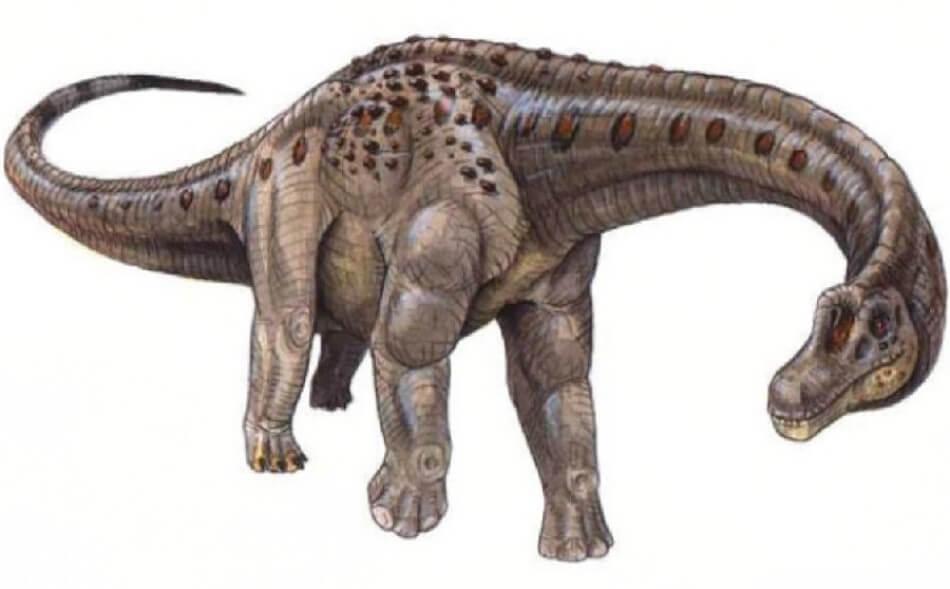
Argyrosaurus, meaning Greek for “silver lizard”, was pronounced ARE-guy-roe-SORE-us. It was a Herbivore that was found in the Woodlands of South America during the Late Cretaceous period, around 80 million years ago. It was 50-60 feet long and weighed around 10-15 tons, and its notable characteristics were: Large size; long neck and tail.
Aristosuchus
Aristosuchus, meaning Greek for “noble crocodile”, was pronounced AH-riss-toe-SOO-kuss. It was a Carnivore that was found in the Woodlands of western Europe during the Early Cretaceous period, around 125 million years ago. It was six feet long and weighed around 50 pounds, and its notable characteristics were: Small size; bipedal posture.
Arrhinoceratops
Arrhinoceratops, meaning Greek for “no-nose horned face”, was pronounced AY-rye-no-SEH-rah-tops. It was a Herbivore that was found in the Woodlands of North America during the Late Cretaceous period, around 70-65 million years ago. It was 20 feet long and weighed around 2-3 tons, and its notable characteristics were: Large frill; two long horns over eyes.
Astrodon
Astrodon, meaning Greek for “star tooth”, was pronounced AS-tro-don. It was a Herbivore that was found in the Woodlands of eastern North America during the Early-Middle Cretaceous period, around 120-110 million years ago. It was 50 feet long and weighed around 20 tons, and its notable characteristics were: Large size; similarity to Brachiosaurus.
Asylosaurus
Asylosaurus, meaning Greek for “unharmed lizard”, was pronounced ah-SIE-low-SORE-us. It was a Unknown; possibly omnivorous that was found in the Woodlands of western Europe during the Late Triassic period, around 210-200 million years ago. It was Undisclosed and weighed around N//A, and its notable characteristics were: Slender build; bipedal posture.
Atlasaurus
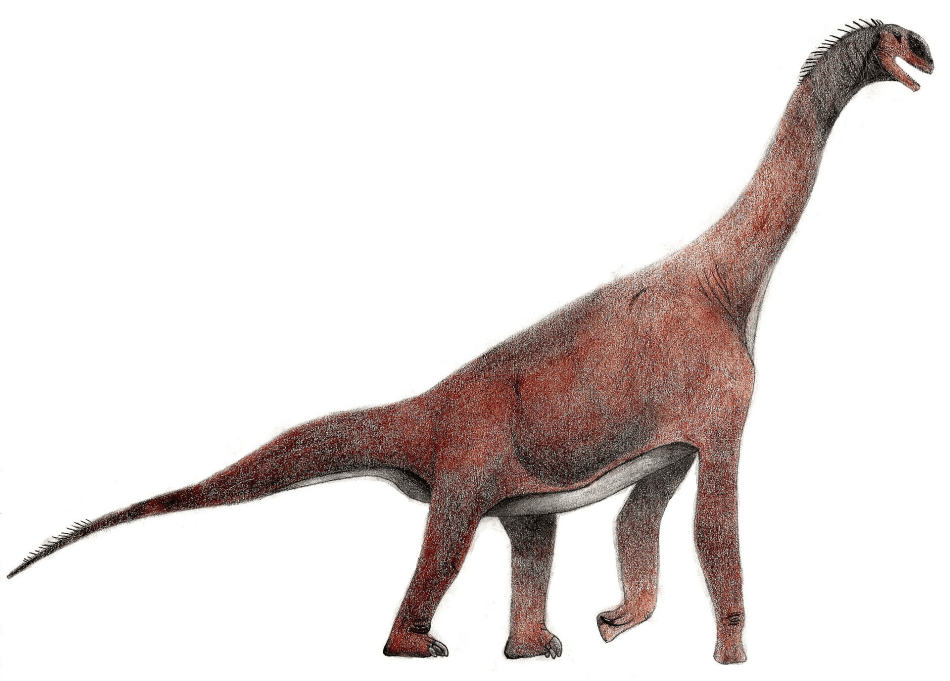
Atlasaurus, meaning Greek for “Atlas lizard”, was pronounced AT-lah-SORE-us. It was a Herbivore that was found in the Woodlands of Africa during the Middle Jurassic period, around 165 million years ago. It was 50 feet long and weighed around 10-15 tons, and its notable characteristics were: Large size; relatively long legs.
Atlascopcosaurus
Atlascopcosaurus, meaning Greek for “Atlas Copco lizard”, was pronounced AT-lass-COP-coe-SORE-us. It was a Herbivore that was found in the Woodlands of Australia during the Early-Middle Cretaceous period, around 120-100 million years ago. It was 10 feet long and weighed around 300 pounds, and its notable characteristics were: Small size; long, stiff tail.
Atrociraptor
Atrociraptor, meaning Greek for “cruel thief”, was pronounced ah-TROSS-ih-rap-tore. It was a Carnivore that was found in the Woodlands of North America during the Late Cretaceous period, around 70 million years ago. It was three feet long and weighed around 20 pounds, and its notable characteristics were: Small size; short snout with backward-curving teeth.
Auroraceratops
Auroraceratops, meaning Greek for “dawn horned face”, was pronounced ore-ORE-ah-SEH-rah-tops. It was a Herbivore that was found in the Woodlands of Asia during the Early Cretaceous period, around 125-115 million years ago. It was 20 feet long and weighed around 1,000-2,000 pounds, and its notable characteristics were: Short, wrinkled head; flat snout.
Australodocus
Australodocus, meaning Greek for “southern beam”, was pronounced AW-stra-la-DOE-kuss. It was a Herbivore that was found in the Woodlands of Africa during the Late Jurassic period, around 150 million years ago. It was 50 feet long and weighed around 10 tons, and its notable characteristics were: Large size; extremely long neck and tail.
Austroraptor
Austroraptor, meaning Greek for “southern thief”, was pronounced AW-stroh-rap-tore. It was a Carnivore that was found in the Woodlands of South America during the Late Cretaceous period, around 70 million years ago. It was 16 feet long and weighed around 500 pounds, and its notable characteristics were: Large size; narrow snout; short arms.
Austrosaurus
Austrosaurus, meaning Greek for “southern lizard”, was pronounced AW-stro-SORE-us. It was a Herbivore that was found in the Woodlands of Australia during the Early Cretaceous period, around 110-100 million years ago. It was 50-60 feet long and weighed around 15-20 tons, and its notable characteristics were: Large size; long neck and tail.
Avaceratops
Avaceratops, meaning Greek for “Ava’s horned face”, was pronounced AY-vah-SEH-rah-tops. It was a Herbivore that was found in the Woodlands of North America during the Late Cretaceous period, around 80-70 million years ago. It was 13 feet long and weighed around one ton, and its notable characteristics were: Short, thick frill; large head with powerful jaws.
Avimimus
Avimimus, meaning Greek for “bird mimic”, was pronounced AV-ih-MIME-us. It was a Carnivore and insects that was found in the Plains of central Asia during the Late Cretaceous period, around 75-70 million years ago. It was five feet long and weighed around 25 pounds, and its notable characteristics were: Bird-like wings; teeth in upper jaw.
